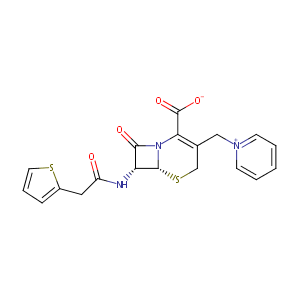Drug Information
| Drug General Information | Top | |||
|---|---|---|---|---|
| Drug ID |
D0F8IO
|
|||
| Former ID |
DIB016401
|
|||
| Drug Name |
Cephaloridine
|
|||
| Synonyms |
cephaloridine; cefaloridine; Cefaloridin; Cephaloridin; Cephaloridinum; Cepaloridin; Cefalorizin; Cephalomycine; Cefaloridinum; Cepalorin; Cefaloridina; Loridine; Ceflorin; 50-59-9; Kefloridin; Glaxoridin; Ceporin; Vioviantine; Intrasporin; Sefacin; Keflordin; Deflorin; Cilifor; Ceporan; Sasperin; Faredina; Ceporine; Keflodin; Verolgin; Lloncefal; Kefspor; Ampligram; Betaine cephaloridine; CHEBI:3537; UNII-LVZ1VC61HB; Cefaloridinum [INN-Latin]; Cefaloridina [INN-Spanish]; N-(7-(2'-Thienylacetamidoceph-3-ylmethyl))-pyridinium-2-carboxylate; SCH
Click to Show/Hide
|
|||
| Drug Type |
Small molecular drug
|
|||
| Indication | Gram-positive bacterial infection [ICD-11: 1B74-1G40] | Withdrawn from market | [1] | |
| Structure |
 |
Download2D MOL |
||
| Formula |
C19H17N3O4S2
|
|||
| Canonical SMILES |
C1C(=C(N2C(S1)C(C2=O)NC(=O)CC3=CC=CS3)C(=O)[O-])C[N+]4=CC=CC=C4
|
|||
| InChI |
1S/C19H17N3O4S2/c23-14(9-13-5-4-8-27-13)20-15-17(24)22-16(19(25)26)12(11-28-18(15)22)10-21-6-2-1-3-7-21/h1-8,15,18H,9-11H2,(H-,20,23,25,26)/t15-,18-/m1/s1
|
|||
| InChIKey |
CZTQZXZIADLWOZ-CRAIPNDOSA-N
|
|||
| CAS Number |
CAS 50-59-9
|
|||
| PubChem Compound ID | ||||
| ChEBI ID |
CHEBI:3537
|
|||
| Interaction between the Drug and Microbe | Top | |||
|---|---|---|---|---|
| The Abundace of Studied Microbe(s) Regulated by Drug | ||||
| The Order in the Taxonomic Hierarchy of the following Microbe(s): Enterobacterales | ||||
|
Studied Microbe: Escherichia
Show/Hide Hierarchy
|
[2] | |||
| Hierarchy | ||||
| Abundance Change | No significant change | |||
| Experimental Species | Human | Experimental Sample | Faeces | |
| Disease or Condition | Healthy | |||
| Description | The abundance of Escherichia was not significantly changed by Cephaloridine. | |||
| The Order in the Taxonomic Hierarchy of the following Microbe(s): Lactobacillales | ||||
|
Studied Microbe: Enterococcus
Show/Hide Hierarchy
|
[2] | |||
| Hierarchy | ||||
| Abundance Change | No significant change | |||
| Experimental Species | Human | Experimental Sample | Faeces | |
| Disease or Condition | Healthy | |||
| Description | The abundance of Enterococcus was not significantly changed by Cephaloridine. | |||
| References | Top | |||
|---|---|---|---|---|
| REF 1 | Drugs@FDA. U.S. Food and Drug Administration. U.S. Department of Health & Human Services. 2015 | |||
| REF 2 | The influence of single dose intravenous antibiotics on faecal flora and emergence of Clostridium difficile. J Antimicrob Chemother. 1985 Mar;15(3):319-26. | |||
If You Find Any Error in Data or Bug in Web Service, Please Kindly Report It to Dr. Zhou and Dr. Zhang.

